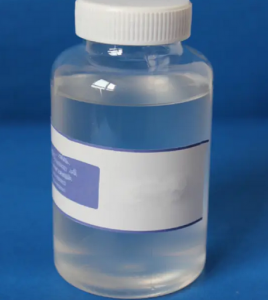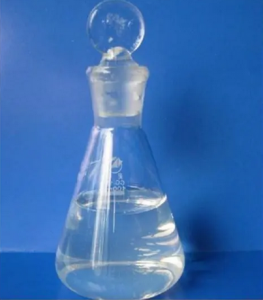
-
Methoxytriphenylsilane CAS NO.1829-41-0 as Silicone origin from China.
Name: Methoxytriphenylsilane CAS No.: 1829-41-0 Appearance: White powdery crystals Molecular weight: 290.43 Bulk density: 1.08 Purity: ≥98% Flash point: No data available Boiling point: 165℃ Melting point: 57℃ Refractive index nD20: No dataTags : Methoxytriphenylsilane CAS NO.1829-41-0 Methoxytriphenylsilane CAS 1829-41-0 C19H18OSi C19H18OSi CAS NO.1829-41-0
-
Hexaphenyldisiloxane CAS NO.1829-40-9 as Silicone origin from China.
Name: Hexaphenyldisiloxane CAS No.: 1829-40-9 Appearance: White granular crystals Molecular weight: 534.79 Bulk density: 0.75 Flash point:>200℃ Boiling point: No data available Melting point: 225℃ Refractive index nD20:1.6825Tags : Hexaphenyldisiloxane CAS NO.1829-40-9 Disiloxane CAS NO.1829-40-9 Hexaphenyldisiloxane CAS 1829-40-9 C36H30OSi2 C36H30OSi2 CAS 1829-40-9
-
3,3,3-Trifluoropropene CAS NO.677-21-4 as Silicone origin from China.
Name: 3,3,3-Trifluoropropene CAS No.: 677-21-4 Molecular formula: CF3CH=CH2 Molecular weight: 96 Physical property constant: b. p. -22 ℃ Appearance: colorless gas Purity: ≥99.8% Moisture content: ≤100ppm Acidity (calculated as HCl): ≤2ppm High boiling point substance: <0.02% Evaporation residue: <0.01%Tags : 3,3,3-Trifluoropropene CAS NO.677-21-4 Trifluoropropene CAS NO.677-21-4 3,3,3-Trifluoropropene CAS 677-21-4 3,3,3-trifluoropropylene CAS NO.677-21-4 C3H3F3 3,3,3-Trifluoroprop-1-ene CAS NO.677-21-4
-
1,1,1,3-Tetrachloropropane CAS NO.1070-78-6 as Silicone origin from China.
Name: 1,1,1,3-Tetrachloropropane CAS No.: 1070-78-6 Molecular formula: CCl3CH2CH2Cl Molecular weight: 182 Physical property constant: b. p.159 ℃ Appearance: Colorless or light yellow transparent liquid Purity: ≥ 99% Packaging: 250 kg/barrel Moisture content: ≤ 0.1%Tags : 1,1,1,3-Tetrachloropropane CAS NO.1070-78-6 1,1,1,3-Tetrachloropropane CAS 1070-78-6 BRN 1734994 Propane, 1,1,1,3-tetrachloro- CAS NO.1070-78-6 C3H4Cl4
-
2-Chloro-3,3,3-Trifluoroprop-1-Ene CAS NO.2730-62-3 as Silicone origin from China
Name: 2-Chloro-3,3,3-Trifluoroprop-1-Ene CAS No.: 2730-62-3 Molecular formula: CF3CCl=CH2 Molecular weight: 130.95 Boiling point ℃: 14 Density g/cm3: 1.295 Appearance: Colorless transparent liquid Purity%: ≥ 99.5 Moisture content: ≤ 100ppm Packaging: 250KG/steel cylinderTags : 2-Chloro-3,3,3-Trifluoroprop-1-Ene CAS NO.2730-62-3 1-propene, 2-chloro-3,3,3-trifluoro- CAS NO.2730-62-3 2-Chloro-3,3,3-trifluoro-1-propene CAS NO.2730-62-3 2-Chloro-3,3,3-Trifluoropropene CAS NO.2730-62-3 2-Chloro-3,3,3-Trifluoroprop-1-Ene CAS 2730-62-3 C3H2ClF3
-
2-Bromo-3,3,3-Trifluoropropene CAS NO.1514-82-5 as Silicone origin from China.
Name: 2-Bromo-3,3,3-Trifluoropropene CAS No.: 1514-82-5 Molecular formula: CF3CBr=CH2 Molecular weight (g/mol): 174.9 Purity%: ≥ 99.5 Appearance: Colorless transparent liquid Boiling point ℃: 34-35 Moisture content: ≤ 100ppm Packaging: 250 KGS/cylinderTags : 2-Bromo-3,3,3-Trifluoropropene CAS NO.1514-82-5 2-Bromo-3,3,3-trifluoro-1-propene CAS NO.1514-82-5 methyl chloro(difluoro)acetate CAS NO.1514-82-5 C3H2BrF3 2-Bromo-3,3,3-Trifluoropropene CAS 1514-82-5 2-bromo-1,1,1-trifluoropropane CAS NO.1514-82-5
-
Trifluoroethyl Methacrylate CAS NO.352-87-4 as Silicone origin from China.
Name: Trifluoroethyl Methacrylate CAS No.: 352-87-4 Molecular formula: C6H7F3O2 Molecular weight (g/mol): 168 Physical property constant: b. p.107 ℃ Appearance: Transparent liquid, chromaticity (APHA): ≤ 20 Purity: ≥ 99.5% Moisture,%: ≤ 0.30 Acid value, mg (KOH)/g: ≤ 0.10 Polymerization inhibitor (MEHQ), ppm: 100 ± 10 (or added according to customer requirements) Packaging: 200 kg/barrelTags : Trifluoroethyl Methacrylate CAS NO.352-87-4 1,1-Dihydroperfluoroethyl methacrylate CAS NO.352-87-4 2,2,2-Trifluoroethyl methacrylate CAS NO.352-87-4 2,2,2-trifluoroethyl 2-methylprop-2-enoate CAS NO.352-87-4 C3H6BrF CAS 352-87-4
-
2,2,2-Trifluoroethanol CAS NO.75-89-8 as Silicone origin from China.
Name: 2,2,2-Trifluoroethanol CAS No.: 75-89-8 Molecular formula: C2H3OF3 Molecular weight (g/mol): 100 Physical property constant: m.p.-43.5 ℃, b.p.73.6 ℃ Appearance: Colorless transparent liquid Purity: ≥ 99.9% Moisture content: ≤ 0.1% PH value: 5-7 Packaging: 250 kg/barrelTags : 2,2,2-Trifluoroethanol CAS NO.75-89-8 Trifluoroethanol CAS NO.75-89-8 Trifluroroethyl alchohol CAS NO.75-89-8 1,1,2-trifluoroethanol CAS NO.75-89-8 2,2,2-Trifluoroethanol CAS 75-89-8 C2H3F3O
-
Hexamethyldisiloxane CAS:107-46-0
Introduction: Hexamethyldisiloxane (silicone ether, MM sealing agent) is a colorless and transparent liquid that is prone to deliquescence. Insoluble in water, soluble in various organic solvents. Used as silicone oil, silicone rubber, pharmaceuticals, gas chromatography stationary liquids, analytical reagents, hydrophobic agents, etc. Obtained by hydrolysis of trimethylchlorosilane. The physical properties of hexamethyldisiloxane colorless and transparent liquids. Easily deliquescent, flammable, and in contact with high heat, open flames, and strong oxidizing agents, there is a risk of combustion. Boiling point 99.5 ℃. Flash point -1.1 ℃. Relative density (d2525) 0.7606. The refractive index is 1.3750. Insoluble in water, soluble in various organic solvents. Hexamethyldisiloxane is an important primary organic silicon raw material, often used as a capping agent in the production of silicone oil, or as a cleaning agent for silicone rubber, pharmaceuticals, gas chromatography stationary liquids, analytical reagents, hydrophobic agents, and medical electronic components. The Si O-Si bond in the molecular chain structure of hexamethyldisiloxane has a high chemical bond energy (460 5 kJ/mol), the polysiloxane prepared from it as a sealing agent has good thermal and chemical stability.Tags : Hexamethyldisiloxane CAS:107-46-0 METHYL Hexamethyldisiloxane from factory Organic silicon primary raw material capping agent
-
Hexamethyldisilane CAS:1450-14-2 (HMD)
Properties of Hexamethyldisilane Melting point 9-12 ° C (lit.) Boiling point 112-114 ° C (lit.) Density 0.715 g/mL at 25 ° C (lit.) Refractive index n20/D 1.422 (lit.) Flash point 29 ° F Storage conditions Store at<=20 ° C Sol common organic solvents; Insul H2O Form liquid Specific gravity 0.729 Colorless Insoluble in water Double in alcohol, ether and acetone Hydrolysis sensitivity 1: no significant reaction with acute systems BRN 1633463 Stability InchiKey NEXSMEBSBIABKL-UHFFFAOYSA-N CAS Database 1450-14-2 (CAS DataBase Reference) NIST Chemical Substance Information Disilane, hexagonal - (1450-14-2) EPA Chemical Substance Information Disilane, hexagonal - (1450-14-2)Tags : Hexamethyldisilane CAS:1450-14-2 HMD Factory direct sales Hexamethyldisilane fast delievery Hexamethyldisilane Quality service Hexamethyldisilane
-
Iodotrimethylsilane CAS:16029-98-4 (TMIS)
Properties of trimethyliodosilane Melting point<0 ° C Boiling point 106 ° C (lit.) Density 1.406 g/mL at 25 ° C (lit.) Refractive index n20/D 1.471 (lit.) Flash point − 25 ° F Storage conditions -20 ° C Solubility Reacts Form Liquid Specific gravity 1.47 Clear colors to reddish Water solubility reactions Sensitivity: Moisture&Light Sensitivity Hydrolysis sensitivity 8: Reacts quickly with moisture, water, protoc solvents BRN 1731136 Stability Sensitivity (Reactive) InchiKey CSRZQMIRAZTJOY-UHFFFFAOYSA-N CAS Database 16029-98-4 (CAS DataBase Reference) NIST Chemical Information Iodotrimethylsilane (16029-98-4) EPA Chemical Information Silane, iodotrimethyl - (16029-98-4)Tags : CAS:16029-98-4 TMIS Iodotrimethylsilane fast delievery Iodotrimethylsilane factory direct sale Iodotrimethylsilane quality service Iodotrimethylsilane
-
Dimethyldimethoxysilane CAS1112-39-6 DMDMS
Specification English name: Dimethyldimethoxysilane CAS number: 1112-39-6 Molecular formula: C4H12O2Si Molecular weight: 120.22 EINECS number: 214 189 4 Mol file: 1112-39-6.mol Applications As a structural control agent, chain extender, and filler treatment agent, it is widely used in the treatment of organic silica gel and white carbon black Purpose As a structural control agent, chain extender, and filler treatment agent, it is widely used in the treatment of organic silica gel and white carbon black. This product is used as a structural control agent and chain extender to improve mechanical processing performance, extend the storage time of rubber blends, and can replace hydroxyl silicone oil for use. Widely used in the treatment of organic silicone and white carbon black Purpose Dimethyldimethoxysilane is used as a structural control agent and chain extender to improve mechanical processing performance, extend the storage time of rubber blends, and can replace hydroxy silicone oil. Widely used in the treatment of organic silicone and white carbon black.Tags : Dimethyldimethoxysilane CAS1112-39-6 DMDMS fast delievery Dimethyldimethoxysilane factory direct sale Dimethyldimethoxysilane quality service Dimethyldimethoxysilane
 call us :
call us :  send a message :
send a message : 





























 online service
online service +8613866722531
+8613866722531

 +8613866722531
+8613866722531